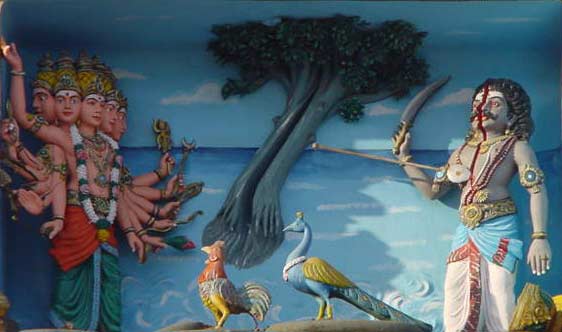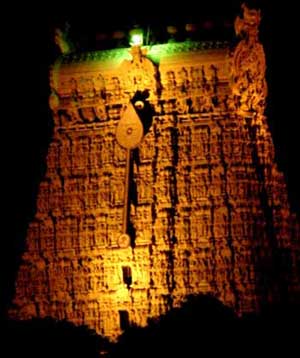
|
||||||||||||||||
|
| ||||||||||||||||
Tiruchendurby R.K. Das
IntroductionOm namah Kārttikeyāya sacchidānanda moortaye "Om! Prostrations unto Karttikeya, the embodiment of Existence-Knowledge-Bliss! -Kumara Tantra
Tiruchendur Temple is the celebrated seashore temple of Lord Subrahmanya. It is situated in the Tiruchendur taluk of the TiruneIveli District. The distance from Madras is about 443 miles. The temple is on the shore of the Gulf of Mannar. The surging cool tides of the sea wash the foot of the temple. There is no other shrine in Tamil Nadu with such a beautiful natural setting. The Gulf of Mannar is shallow and is safe for sea bath. Before entering the temple pilgrims either wash their feet or take a bath in the sea. The bathing that contains nine teerthams according to the sthalapuranam. A bath in any of these teerthams is believed to confer miraculous benefits on a devotee. It is said that once, when Brahma lost one of his five heads due to the anger of Śiva, he came to this teertha, took a holy dip in it and had his head restored. Similarly one Angasundari, a Pandyan princess born with the face of a horse, was blessed with a beautiful face after a bath at Vathararamba Teertham.
Nazhi KinaruAbout 200 yards south of this temple, at the seashore, there is a rare natural phenomenon inside a square. It is a well 14 sq. feet in area and with a flight of 34 steps. Inside this well, there is another small well, one square foot in extent and seven feet deep. The water in the smaller well is crystal clear and sweet to taste whereas that in the bigger well is highly sulphurous in smell and brackish. It is said that when Shanmukha's troops returned to the shore after vanquishing Surapadman at Mahendragiri, they felt thirsty and wanted fresh water. To quench their thirst, Shanmukha planted his Vel on this spot and caused fresh water to gush out. It is necessary to know the origin of Subrahmanya, or Muruga, or Shanmukha as he is differently called by his votaries. The Puranic account runs as follows: The Puranic accountKarttikeya desired to worship his fattier, Śiva. As there was no Śiva shrine there, Maya, the celestial architect, constructed the temple of Śiva in the sea front and Subrahmanya worshipped there. This is said to be the origin of this holy abode of Lord Kumara. Each temple has its own sanctity. Yet there is difference in degree. This shrine of Tiruchendur is believed to be most liked by Subrahmanya and has been given the second place among His shrines in the Skanda puranam, the first being Palani. According to the physiographical five-fold division of land, Muruga is assigned the hill country, Kurinji, and his shrines are invariably situated amidst mountains or forests as such places are dear to him. The deviation from the usual, in this case, is due to the mission that he undertook in behalf of the devas. Just as Surapadman was troubling the devas in the South, another demon named Tarakasura, brother of Surapadman, was troubling them in the North. Muruga killed Tarakasura at Cambay, situated between Mahe and Sabaramati rivers, known in olden days as Kambhat, and erected a pillar of victory (sthamba) in commemoration of his success. Similarly the Tiruchendur temple also may be considered as a commemoration of the defeat of
On the sixth day, Surapadman alone survived. The Lord's last bid to show the asura his grace was his Viswarupa. Darsan Demon Surapadman realised then the divinity of his enemy Muruga, but yet would not accept defeat. He continued his fight from region to region. Karttikeya took Indra as his vehicle in the form of a peacock and his lance, the Vel, sought the foe out of his hiding place in the ocean. At last Surapadman came out of his island fortress of Veera Mahendra, rose in the form of a terrible mango tree and attacked him. The lance of Karttikeya pierced the tree and broke it into two. The broken pieces instantly turned into a peafowl and a cock. The former attacked Indra (Lord Subrahmanya's charger) with no success. The demon would not yet accept defeat. But Shanmukha's grace was so bountiful that, as an act of forgiveness, he took the peafowl as his permanent vehicle, relieved Indra of his duties and put the cock on his banner. As Surapadman was a Brahman, the sin of Brahma Hatti affected Subrahmanya. He became pitch black in complexion and his beautiful shape was changed. As a result of this he prayed at Sikkal, took bath in the tank made out of the milk of Kamadhenu, the celestial cow, and got back his original beautiful form and complexion. This is why Muruga is worshipped as Singaravelar at Sikkal in the Tanjore District.
Lord Muruga is known to have two consorts, Valli and Teyvayanai. But in Northern India, Karttikeya is called Kumara or bachelor god. He is fervently worshipped there as a heavenly boy with powers to confer heavenly gifts to his devotees. Hence the name of Bala Subrahmanya. Skanda ShashtiThe war against Surapadman and the success over him are celebrated every year at Tiruchendur on the days till Skanda Shashti, i.e. the sixth day of the waxing moon in the Tula month (October - November). These six days are considered to be very sacred in the Hindu religious calendar. The Kanda Puranam is read at this time with devotion, in private houses and in the temple, with the hope of getting both material and spiritual benefits from Lord Skanda. Many devotees observe nirjala fast on these days that are they do not drink even water. Originally the temple was of a very modest construction, but during the course of about one thousand years many additions and alterations were made by different Pandya and Chera kings, their vassals, and the wealthy people of the locality, as a result of which the present gigantic structure has grown up. 'Tiruchendur' means a sacred and prosperous 'Town of Victory'. The temple was originally constructed on the sandstone reefs of the beach, but due to corrosion by the sea, the stone began to disintegrate. A noble sannyasin, Mauna Swami, took up the renovation work and it was followed by two others in succession for 72 years and the noble edifice of three prakarams was constructed anew in black granite stone. The gopuram is on the west (instead of being in the east as usual because of the sea) and is a gigantic structure of nine storeys with a height of 137 feet, commanding a good view of the surrounding area. History states that the gopurarn was constructed roughly 300 years ago by Desikamurti Swami, an Odukathu Tambiran of the then Head or Maha Sannidhanam of Tiruvaduturai Mutt, Tanjore District. Courtesy: R.K. Das
|



